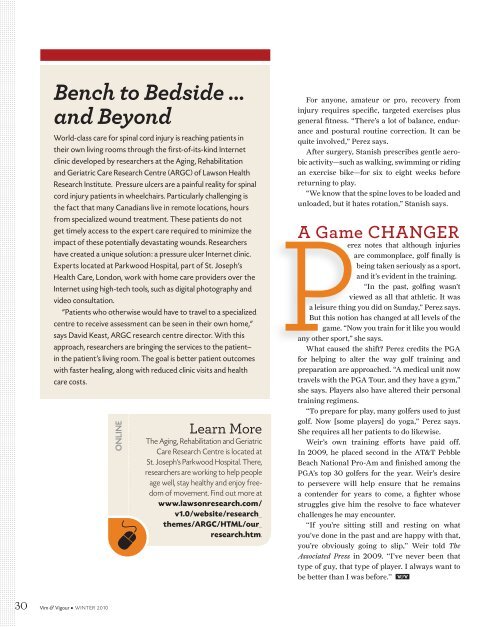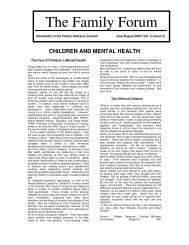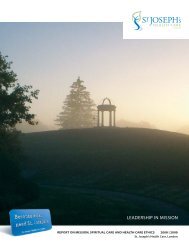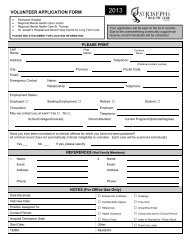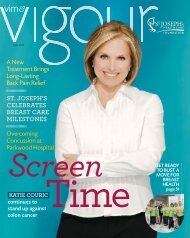Winter 2010 - St. Joseph's Health Care London
Winter 2010 - St. Joseph's Health Care London
Winter 2010 - St. Joseph's Health Care London
You also want an ePaper? Increase the reach of your titles
YUMPU automatically turns print PDFs into web optimized ePapers that Google loves.
30<br />
Bench to Bedside …<br />
and Beyond<br />
World-class care for spinal cord injury is reaching patients in<br />
their own living rooms through the first-of-its-kind Internet<br />
clinic developed by researchers at the Aging, Rehabilitation<br />
and Geriatric <strong>Care</strong> Research Centre (ARGC) of Lawson <strong>Health</strong><br />
Research Institute. Pressure ulcers are a painful reality for spinal<br />
cord injury patients in wheelchairs. Particularly challenging is<br />
the fact that many Canadians live in remote locations, hours<br />
from specialized wound treatment. These patients do not<br />
get timely access to the expert care required to minimize the<br />
impact of these potentially devastating wounds. Researchers<br />
have created a unique solution: a pressure ulcer Internet clinic.<br />
Experts located at Parkwood Hospital, part of <strong>St</strong>. Joseph’s<br />
<strong>Health</strong> <strong>Care</strong>, <strong>London</strong>, work with home care providers over the<br />
Internet using high-tech tools, such as digital photography and<br />
video consultation.<br />
“Patients who otherwise would have to travel to a specialized<br />
centre to receive assessment can be seen in their own home,”<br />
says David Keast, ARGC research centre director. With this<br />
approach, researchers are bringing the services to the patient—<br />
in the patient’s living room. The goal is better patient outcomes<br />
with faster healing, along with reduced clinic visits and health<br />
care costs.<br />
Vim & Vigour · WINTER <strong>2010</strong><br />
online<br />
Learn More<br />
The Aging, Rehabilitation and Geriatric<br />
<strong>Care</strong> Research Centre is located at<br />
<strong>St</strong>. Joseph’s Parkwood Hospital. There,<br />
researchers are working to help people<br />
age well, stay healthy and enjoy freedom<br />
of movement. Find out more at<br />
www.lawsonresearch.com/<br />
v1.0/website/research_<br />
themes/ARGC/HTML/our_<br />
research.htm.<br />
For anyone, amateur or pro, recovery from<br />
injury requires specifi c, targeted exercises plus<br />
general fi tness. “There’s a lot of balance, endurance<br />
and postural routine correction. It can be<br />
quite involved,” Perez says.<br />
After surgery, <strong>St</strong>anish prescribes gentle aerobic<br />
activity—such as walking, swimming or riding<br />
an exercise bike—for six to eight weeks before<br />
returning to play.<br />
“We know that the spine loves to be loaded and<br />
unloaded, but it hates rotation,” <strong>St</strong>anish says.<br />
A Game CHANGER<br />
erez notes that although injuries<br />
are commonplace, golf fi nally is<br />
being taken seriously as a sport,<br />
and it’s evident in the training.<br />
“In the past, golfi ng wasn’t<br />
viewed as all that athletic. It was<br />
a leisure thing you did on Sunday,” Perez says.<br />
But this notion has changed at all levels of the<br />
game. “Now you train for it like you would<br />
any other sport,” she says.<br />
What caused the shift? Perez credits the PGA<br />
for helping to alter the way golf training and<br />
preparation are approached. “A medical unit now<br />
travels with the PGA Tour, and they have a gym,”<br />
she says. Players also have altered their personal<br />
training regimens.<br />
“To prepare for play, many golfers used to just<br />
golf. Now [some players] do yoga,” Perez says.<br />
She requires all her patients to do likewise.<br />
Weir’s own training efforts have paid off.<br />
In 2009, he placed second in the AT&T Pebble<br />
Beach National Pro-Am and fi nished among the<br />
PGA’s top 30 golfers for the year. Weir’s desire<br />
to persevere will help ensure that he remains<br />
a contender for years to come, a fi ghter whose<br />
struggles give him the resolve to face whatever<br />
challenges he may encounter.<br />
‘‘If you’re sitting still and resting on what<br />
you’ve done in the past and are happy with that,<br />
you’re obviously going to slip,’’ Weir told The<br />
Associated Press in 2009. ‘‘I’ve never been that<br />
type of guy, that type of player. I always want to<br />
be better than I was before.’’


